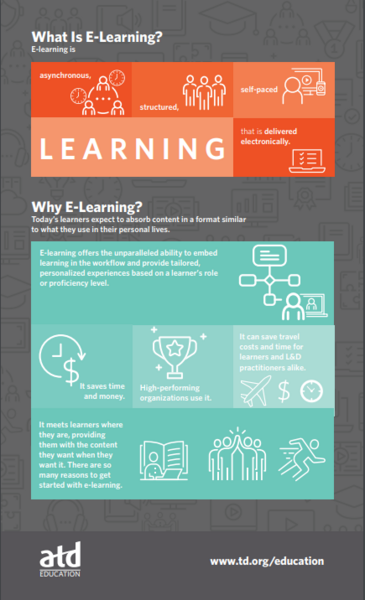ATD Blog
E-Learning: Why You Need to Know—and Use—It Now
Wed Jan 09 2019

According to ATD's 2018 State of the Industry Report, the percentage of companies offering the majority of their learning assets as e-learning is expected to double between 2017 and 2022. Additional ATD Research notes that high-performing organizations are more likely to feature a greater portion of their learning materials as e-learning, and that portion is growing. E-learning, as defined by the ATD Research report Next Generation E-Learning: Skills and Strategies, is “asynchronous, structured, self-paced learning that is delivered electronically.”

Why is e-learning so popular, and how can L&D professionals grow their skills to provide this highly regarded development method?
Why E-Learning?
E-learning works on multiple levels. Logistically, it can be used for an increasingly virtual and global workforce. Further, it’s available when learners are ready and have time to learn. Today’s learners expect to absorb content in formats that are similar to what they use in their personal lives. For the L&D professional, e-learning is scalable for a greater number of learners. It also can save travel costs and time for learners and L&D practitioners alike. Then, there’s the convenience factor: there’s no need to try to coordinate everyone’s schedule.
Indeed, in his ATD Insights article, “Excel in E-Learning Design and Emerge as a Skilled Leader,” Jeff Surprenant, senior manager of curriculum development at ATD, writes that e-learning “offers the unparalleled ability to embed learning in the workflow and provide tailored, personalized experiences based on a learner’s role or proficiency level.”
But even with these advantages, e-learning would not make sense for organizations if it didn’t work. The number of classes that are available online is nearly limitless, offering choice to adults who “tend to prefer self-directed, autonomous learning,” Linda Russell writes in the ATD Links article, “The Fundamentals of Adult Learning.” Further, because of the types of content available, L&D professionals can offer content to learners in a variety of methods, giving learners access to their preferred format and how they best learn.
Developing Your E-Learning Skills
Talent development professionals just starting out with e-learning should be warned that it’s not as simple as moving learning content to an online platform. Developing e-learning assets requires a new set of skills and competencies, while understanding that the learner is still front and center. Fortunately, you’re not alone. Tools and tips from TD pros who have done it successfully are there for you.
What’s the Same? As David Smith writes in “6 Steps to Moving Your Training Online,” with the addition of technology and such methods as gamification, “we still have to attend to the fundamental basics, such as setting the right foundations for our learning programs.” Questions that need to be answered include those around business need and, from that, what learners need to gain proficiency in. Can those skills be acquired in the e-learning environment? If repurposing existing content, is it still relevant? Do learners have access to technology at their location? Are they comfortable using the tools that are necessary for the e-learning module?
What Content? Compliance training, onboarding, technical skills training, microlearning, performance support tools, business acumen, and customer service training: These are among the types of learning for which e-learning assets can be used according to ATD Research. ATD 2018 BEST Award winner Tata Consultancy Services (TCS), located in Mumbai, India, uses e-learning extensively: 90 percent of its learning content is available online. The company’s Global Learning Week “generated more than 20,000 hours of learning and resulted in a visible increase in self-paced learning.” Given the amount of content available in e-learning format, TCS’s learning team is able to point employees to the right learning opportunities “through cleverly engaging means.”
What Methods? E-learning, as ATD Research explains, may include “pre-recorded lecture content and video, visuals, and/or text, knowledge quizzes, simulations, games, and other interactive elements.” AIG, a global insurance leader, is one company that uses some of these formats. Specifically, it uses three microlearning sites for leadership development. Former chief learning officer Dan Lovely explains that “Leaders need to be personally inspiring, they need to be focused on organizational performance, and they need to be skilled developers—of themselves and the people they manage.” So Lovely and his team designed modules that were rolled out with a three-month emphasis on each of those three aspects. ATD Research encapsulated it, “Content is varied, uses e-learning, and is built to engage the leaders consuming it. The content also includes a lot of videos, which the team either produced or found through open source.”
What Technology? There are a variety of tools available for e-learning authoring. Diane Elkins, a past speaker at ATD Core 4, explains in a video that the best tool for your project depends on what’s important to you. This may be as it relates to price, ease of use, quizzing, power, and so forth. Some of the questions to be considered, for example, include:
Do you value convenience more than creative freedom?
Is tracking user data critical?
Is technical support included in the quoted price?
Does your learning team have the skills for a more complex authoring tool?
Is there a community of other users or some other resource available for any questions you may have?
Now It’s Your Turn!
High-performing organizations use it. It saves time and money. It meets learners where they are, providing them the content they want when they want it. There are so many reasons to get started with e-learning. What are you waiting for?
ATD TechKnowledge 2019 offers several preconference certificate programs to help you build your e-learning development expertise you can immediately put to work in your organization. For those just starting out, check out the E-Learning Instructional Design Certificate, Microlearning Certificate, or Rapid Video Development for Learning Certificate, to name a few. Developers with more experience under their belt might want to explore ATD Master E-Learning Instructional Designer™ Program or the Mobile Learning Certificate.
